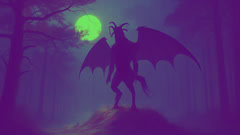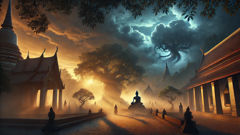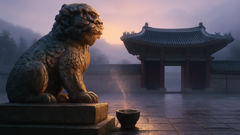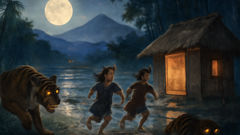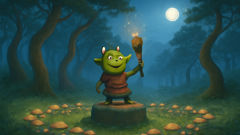Introduction
In the heart of New Jersey lies a wilderness both ancient and enigmatic: the Pine Barrens. This sprawling forest is a land of tangled undergrowth, whispering pines, and shifting mists that roll in as night falls, muffling all but the urgent chirr of insects and the distant call of an owl. Here, legends sink their roots deep into the sandy soil—none more chilling than the tale of the Jersey Devil. Colonial settlers feared these woods for more than just their isolation. They told stories of a creature, born of anger and misfortune, whose very name was spoken in hushed tones. The Pine Barrens, with their labyrinth of cedar swamps and lonely trails, have always been a place where the line between reality and myth blurs, and where every shadow might conceal a secret.
The Jersey Devil is not just a monster but a symbol—of curses, consequences, and the untamed spirit of the land itself. The legend begins with a woman, a desperate mother, and a night thick with sorrow. Her thirteenth child, it is said, entered the world with a scream that echoed through the pines, transforming before horrified eyes into something neither human nor beast. With bat-like wings, cloven hooves, and a forked tail, the creature burst through the roof of the Leeds family home and vanished into the endless dark. For centuries, people have claimed to glimpse it gliding among the trees or hear its piercing cry on windless nights. Some say it is a warning, others a curse that still haunts the land. But all agree that the Pine Barrens are its domain, and that to enter its depths is to risk meeting the Devil himself.
The Thirteenth Child: A Curse is Cast
The year was 1735. In a weather-beaten cottage nestled among the gnarled pines near Leeds Point, Deborah Leeds labored through the birth of her thirteenth child. The world outside was battered by rain; thunder rolled through the forest as if in sympathy with her pain. Deborah was a woman hardened by life’s trials. Her husband, a man of few words and many debts, worked the land with little success. Twelve children already filled their home with hungry mouths and endless chores, and each new birth was a reminder of how fragile security could be in the wilds of colonial New Jersey.
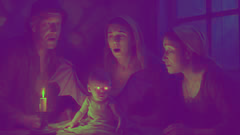
That night, fear and frustration weighed heavily on Deborah’s heart. Tales of witches and omens were common among her neighbors. Some whispered about the unlucky number thirteen, others about the dark spirits rumored to dwell in the Barrens. As contractions wracked her body, Deborah felt an overwhelming sense of dread. When at last the child was born—a boy, silent and still—she looked upon him with a mixture of exhaustion and terror. In a moment of despair, her voice cracked the silence: “Let this one be the devil!”
It was a curse uttered in anger, but in the Barrens, words held power. The child’s skin mottled and stretched. His eyes snapped open, glimmering red in the flickering firelight. Limbs twisted, bones reshaped. Wings sprouted from his back, leathery and dark. His hands curled into claws; his feet split into hooves. Those present recoiled, gasping, unable to move as the creature screamed—an unearthly sound that rose and fell like the wind through the trees. With one powerful leap, it shattered the window and disappeared into the storm.
In the days that followed, word of the birth spread like wildfire. Neighbors gathered in small, anxious knots, their faces pale as they recounted the tale. Some blamed Deborah for tempting fate. Others spoke of the Devil’s work, claiming the Pine Barrens had always been a place where evil found root. Deborah herself faded into shadow, her eyes haunted by regret and fear. The Leeds house soon stood empty, the family vanished into obscurity, but their legacy was now forever entwined with the legend of the Devil of the Pines.
The forest seemed changed after that night. Animals moved warily, as if sensing an unseen presence. Children were kept indoors after dusk, and travelers hurried along the sandy roads. And always, there were stories—of hoofprints found in snow where no animal had passed, of livestock slaughtered without cause, of a shadow flitting among the branches, watching, waiting. The Jersey Devil had come to claim its home.
Echoes Through the Pines: Sightings and Superstitions
The Jersey Devil quickly became more than a tale whispered around the fire. For years, those living at the edge of the Pine Barrens reported strange occurrences. The creature’s cry—a piercing, unearthly wail—was said to freeze even the bravest souls in their tracks. Farmers found their livestock mutilated, tracks stamped deep in the earth, as if a heavy beast had passed through. Some hunters spoke of glimpses: bat-like wings sweeping through the mist, yellow eyes staring from between blackened trunks, a shape both agile and grotesque.
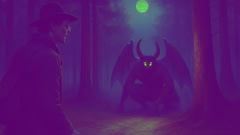
Superstitions flourished in the Barrens. Mothers braided iron charms into their children’s hair. Doors were marked with ash to ward off evil. Every unexplained misfortune—from failed crops to sudden illnesses—was attributed to the Devil of the Pines. It was said that on certain moonless nights, the creature would circle above the treetops, its shadow blotting out the stars, seeking vengeance or perhaps simply feeding on fear. Candlelit gatherings were held to offer prayers or plead for mercy. Yet, for all their rituals, no one felt truly safe.
As the years passed, the legend grew. Some claimed to have seen the Devil cross roads at dusk, its silhouette enormous against the horizon. Others reported horses bolting for no reason, dogs howling at nothing visible. A traveling peddler recounted a chilling encounter—while camping near a cedar swamp, he awoke to find the remains of his meal scattered and deep gouges in the bark overhead. His horse refused to return to the clearing, eyes rolling with terror.
Tales of the Devil became a kind of currency among those who called the Barrens home. Each story was more vivid than the last: the creature perched atop a roof, staring down with intelligence and malice; the sound of its wings thundering overhead during a storm; a feeling of being watched when alone among the pines. The legend wove itself into daily life, shaping traditions and sowing caution.
Yet not all stories ended in terror. Some spoke of chance encounters in which the Devil did not attack but simply watched, almost curious. A few believed the creature was not purely evil but a spirit trapped by a mother’s curse, longing for peace. Regardless of intent, its presence lingered—a reminder of how wild and mysterious the Barrens could be, and how easily fear takes root in the unknown.
A Devil Among Us: The Jersey Devil in Colonial Life
Colonial life in New Jersey was hard enough without the shadow of the Devil haunting every wood and marsh. Settlers learned to respect—and sometimes fear—the Pine Barrens. The land was stubborn: soil thin and acidic, crops reluctant to grow. Yet the woods provided timber and charcoal, and those who braved its depths became a breed apart—resourceful, independent, and wary of outsiders.
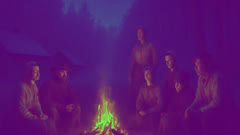
Stories of the Jersey Devil shaped the community. Children were warned never to stray from marked trails; young men dared one another to visit the old Leeds homestead after dark. Preachers railed against sin, using the Devil as a cautionary tale of what happens when one tempts fate. Merchants passing through the region carried talismans and avoided travel at night. The legend made its way into sermons, songs, and even legal records—there were accounts of juries refusing to convict those who claimed their misdeeds were driven by fear of the creature.
Despite—or perhaps because of—the fear it inspired, the Jersey Devil became a symbol of local pride. Residents saw themselves as survivors, tough enough to live in a land haunted by legends. Some even profited from the stories: enterprising souls carved “Devil’s hoof” prints into snow near taverns to attract curious travelers. Ballads and broadsides circulated, recounting daring escapes and near-misses with the creature. The Pine Barrens became known far beyond New Jersey as a place where the ordinary laws of nature no longer applied.
The Leeds family name faded into local history, shrouded in rumor. Some said they had fled to Philadelphia to escape blame. Others believed Deborah Leeds herself still wandered the woods, searching for her lost child—or perhaps for forgiveness. As years passed, the line between fact and folklore blurred. The Jersey Devil became part of the region’s identity: a reminder that even in a world governed by reason, there are places where mystery still rules.
But for those who lived on the edge of the Barrens, the legend was never just a story. Every snapping branch or rustle of wings in the night sent hearts pounding. The Devil was out there—somewhere—waiting. Its story was woven into every wind-whipped pine, every fog-shrouded hollow. And in the hush before dawn, when the world seemed to hold its breath, the people of New Jersey listened for the cry that had haunted their ancestors for generations.
Conclusion
Centuries have passed since the stormy night when Deborah Leeds’ curse echoed through the Pine Barrens. The world has changed—the wilds are crossed by highways, towns have sprung up where only pines once stood, and yet, the legend endures. Modern sightings still surface: motorists glimpse something strange darting across lonely roads, hikers hear unsettling cries deep among the cedars. The Jersey Devil has become more than a figure of fear; it’s a symbol of New Jersey’s wild heart—a reminder that some mysteries are never meant to be solved.
The Pine Barrens remain a landscape where history, myth, and nature intertwine. The story of the Jersey Devil persists because it speaks to something universal: the fear of the unknown, the weight of words spoken in anger, and the power of place to shape our imaginations. Whether the creature truly stalks the woods or lives only in our minds, it continues to inspire awe and caution. To walk beneath those towering pines is to feel the eyes of the past upon you—and to wonder what might be watching from the shadows.

